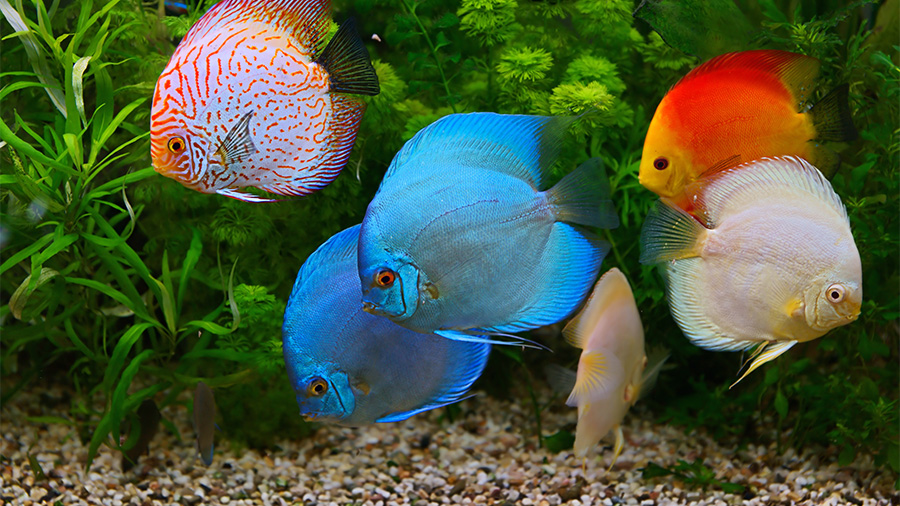Fish are the perfect starter pet for kids and adults, right? Well, it may not be as simple as you think. To avoid mishandling and other problems that result in the needless death of the fish, people should take the time to learn how to properly care for them.

“While all of our pets rely on us for care, fish in our homes live in an environment analogous to living in a spaceship,” says Dr. Judilee Marrow, a veterinarian in the zoological medicine service at the University of Illinois Veterinary Teaching Hospital. “We must provide our pet fish with everything from oxygen to food and strive to provide the best care we can.”
Here are some of Dr. Marrow’s husbandry tips and tricks to keep your underwater family members healthy.
Setting Up the Tank
Before purchasing a fish, research what each individual species needs in their environment so the tank can be set up accordingly.
“Owners should pay particular attention to the environment parameters, such as temperature, pH, and light, to ensure that they have the optimal environment,” Dr. Marrow explains. “Not all fish that live in fresh water will be able to live together. The required microclimates of the environment might not be compatible.
“New tanks may not be ready for fish to live in them for two to four weeks. Adding fish to a tank before it has had time to establish a normal equilibrium of bacteria—known as biofiltration—can expose fish to toxic levels of waste, which is produced by normal break down and elimination of food by the fish,” adds Dr. Marrow.
This also applies to any current fish owners looking to add another species to their tank.
“If a fish owner has an established tank and is adding a new fish to the tank—even if it is a species they already have—we strongly recommend setting up a separate tank for quarantining the new animal before it enters the tank,” Dr. Marrow adds.
Maintaining Fish at Home
If you are a first-time fish owner, you should pay attention to the way your new fish is acting in its environment. If your fish is happy and healthy, it will appear active, have normal coloration, and have a good appetite.
Routine fish care involves monitoring the water chemistry and adjusting any problems before they harm the fish. At a minimum, it is recommended that fish owners measure nitrogenous waste levels (ammonia, nitrite and nitrate), temperature, pH, and dissolved oxygen. Parameters like dissolved oxygen and temperature should be evaluated every day.
“Nitrogenous waste” is a term for nitrogen-based end products of metabolism that cannot be used by the animal and are therefore excreted in urine or feces. Fish urinate and defecate in their environment, and without proper cleaning, this excrement can build up and become toxic to the fish.
In newer tanks, measuring water parameters can be as frequently as daily but in established tanks monitoring nitrogenous waste levels and pH is recommended to be performed weekly and minimally with each water change. “There are commercial test kits available for pet fish owners to use at home,” says Dr. Marrow.
The pH and temperature needs of the fish depend on the species. “Dissolved oxygen also needs to be measured immediately within the tank water, as this lets you know what the fish have available to breath,” Dr. Marrow explains. She also mentions chlorine, chlorine-like compounds, salinity, hardness, and alkalinity as other values that may be important to measure to ensure the fish continues to flourish in its environment.
Appropriate Handling
If the fish needs to be moved out of its environment for any reason, it is important to handle it with care and wear gloves or use a fine mesh net.
“Fish are covered by a protective layer of mucus that helps to keep pathogens out of their body. Immune cells are imbedded in their skin to help fight off infections too,” Dr. Marrow states. “Rough handling can cause disruption of the mucus and the skin, allowing pathogens from the water all around them to get into their body and cause disease.”
Not only rough handling but also change in environment and other stressors predispose fish to a variety of bacterial, viral, and parasitic infections.
Avoid Overfeeding Your Pet Fish
While you want your fish to have a good appetite, that doesn’t mean it should eat all it wants. Just as you should not overfeed your dog or cat, you should not overfeed your fish.
“Obesity can occur because the fish is being overfed, is being fed the wrong diet, or receives a diet that is not as diverse as it would naturally eat,” explains Dr. Marrow. “Obesity also arises because of lack of exercise in the home fish tank.”
It may also be true, in established tanks with multiple fish, that some fish eat more food than other fish. In this case, Dr. Marrow recommends “target feeding,” or directing food toward the fish that are not receiving as many nutrients as they need.
Know What Healthy Looks Like
Owners need to know what a healthy specimen of their species of fish looks like in order to identify changes that indicate disease.
“Fish that are sick may exhibit abnormal behaviors, such as rubbing on tank surfaces, gulping at the surface, and hiding,” says Dr. Marrow. “They may also engage in abnormal breathing or display abnormal coloration.”
Lastly, Dr. Marrow strongly recommends working with a veterinarian familiar with pet fish.
“You’ll find an abundance of information on the internet about how pet owners can diagnose and treat conditions in their fish at home. Unfortunately, many of these recommendations can actually make your fish worse,” Dr. Marrow cautions. “Having an experienced veterinarian to evaluate your pet fish and provide care is invaluable.”
The zoological medicine service at the University of Illinois has three boarded veterinarians with specialty training working with fish and provides expert care for fish and other zoological companion species.
By Lauren Bryan




